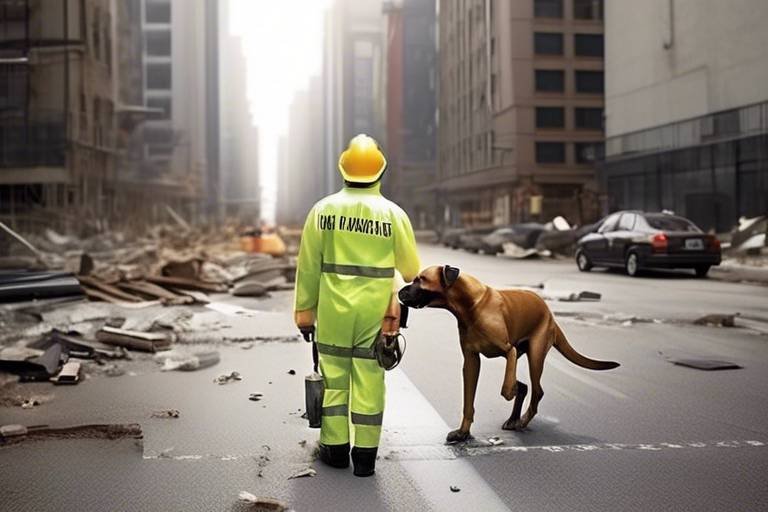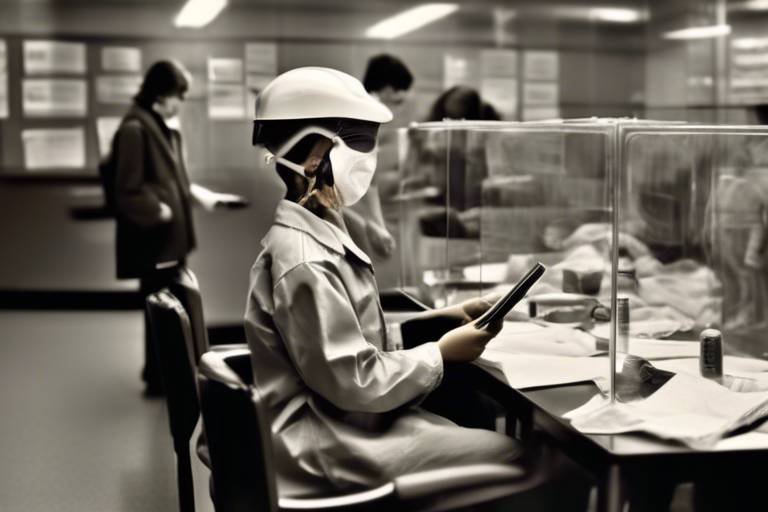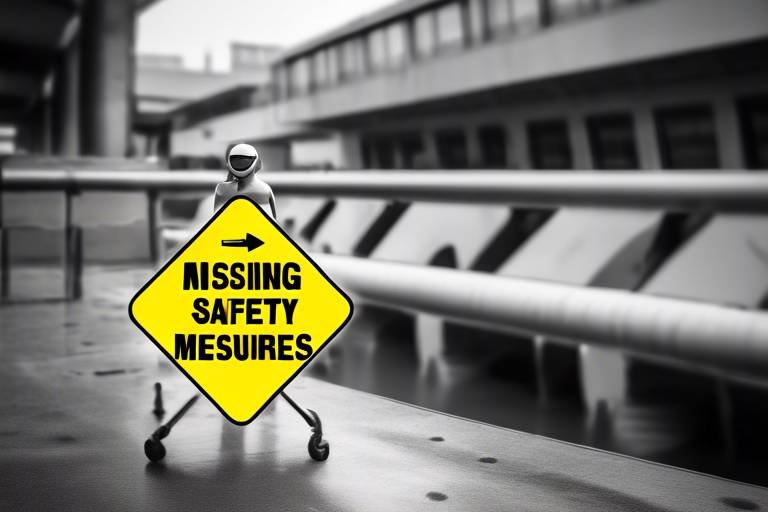Human Behavior: An Unspoken Catalyst in Safety Measures
In today’s world, safety is often seen as a series of protocols, checklists, and regulations that organizations must adhere to. However, what many fail to realize is that the real catalyst for effective safety measures lies within human behavior. Our decisions, perceptions, and attitudes shape how safety protocols are followed or ignored. Imagine a workplace where everyone complies with safety measures not because they are forced to, but because they genuinely understand their importance. This shift in mindset can dramatically enhance safety outcomes across various sectors.
Consider this: every time an employee chooses to wear a helmet or follow safety guidelines, they are making a conscious decision influenced by their understanding of risk and safety. This article delves into the profound impact of human behavior on safety measures, emphasizing that to truly enhance safety, we must first understand the psychological factors at play.
Human behavior is complex and influenced by numerous factors, including motivation, perception, and attitude. These elements not only dictate how individuals perceive risks but also how they respond to safety protocols. For instance, if an employee perceives a task as dangerous, they are more likely to adhere to safety measures. Conversely, if they underestimate the risks, compliance may dwindle. Therefore, understanding these psychological underpinnings is crucial for developing effective safety strategies.
Moreover, the role of effective training cannot be overstated. Training programs that are well-structured and engaging can significantly influence behavior. They not only provide knowledge but also foster a culture of safety within organizations. Employees who feel confident in their understanding of safety protocols are more likely to follow them diligently. This creates a ripple effect, where safety becomes a shared responsibility rather than an individual task.
As we explore the intricate relationship between human behavior and safety measures, it’s essential to recognize the influence of group dynamics and communication. The interactions within teams can either promote or hinder safety practices. A supportive team environment encourages individuals to speak up about safety concerns, leading to a more proactive approach to risk management. Clear communication of safety protocols is vital in this regard, as it ensures everyone is on the same page, reducing the likelihood of accidents.
In summary, understanding human behavior is not just an academic exercise; it's a practical necessity for enhancing safety measures. By addressing the psychological factors that influence compliance, investing in effective training, and fostering open communication, organizations can create a safer environment for everyone involved. The journey towards improved safety starts with recognizing the unspoken yet powerful role of human behavior.
- Why is human behavior critical in safety measures? Human behavior determines how individuals perceive risks and comply with safety protocols, making it essential for effective safety management.
- How can organizations improve safety compliance? By understanding psychological factors, providing effective training, and fostering a culture of open communication, organizations can enhance safety compliance.
- What role does training play in safety culture? Effective training shapes employees' behaviors and attitudes towards safety, promoting a culture where safety is prioritized and practiced consistently.
- How does group dynamics affect safety practices? Team interactions can either support or undermine safety practices, making it crucial to cultivate a positive and collaborative safety culture.

The Psychology of Safety Compliance
Understanding the psychology behind safety compliance is not just an academic exercise; it's a necessity for creating safer workplaces and environments. At its core, safety compliance is driven by a complex interplay of motivations, perceptions, and attitudes. Why do some individuals meticulously follow safety protocols while others disregard them? The answer often lies in their psychological makeup. For instance, individuals who perceive a high level of risk are more likely to comply with safety measures. This perception can be influenced by personal experiences, training, and even cultural backgrounds.
Moreover, the motivation to comply with safety protocols can stem from various sources. Some people may be driven by a genuine concern for their own well-being or that of their colleagues, while others might be motivated by external factors such as rewards or penalties. Understanding these motivations can help organizations tailor their safety programs more effectively. For example, a workplace that offers incentives for safe behavior can significantly enhance compliance rates. This is where the psychology of behavioral incentives comes into play.
Another critical aspect to consider is the attitude of employees towards safety. Attitudes are shaped by a variety of factors, including prior experiences, the influence of peers, and the organizational culture. When employees perceive safety as a top priority within their organization, they are more likely to adopt safe practices. Conversely, if safety is seen as an afterthought, compliance can suffer. This highlights the importance of fostering a culture that prioritizes safety at all levels.
To illustrate this point further, let’s consider a few key psychological factors that influence safety compliance:
- Self-efficacy: Individuals who believe they can perform tasks safely are more likely to comply with safety protocols.
- Social norms: The behavior of peers can significantly impact an individual's compliance. If safety is valued within a team, individuals are more likely to adhere to safety measures.
- Fear of consequences: The potential for negative outcomes, such as injury or disciplinary action, can motivate compliance.
In conclusion, the psychology of safety compliance is a multifaceted issue that requires a deep understanding of human behavior. By recognizing the motivations, perceptions, and attitudes that drive compliance, organizations can develop more effective safety strategies. This not only enhances safety outcomes but also fosters a culture where safety is a shared responsibility. As we delve deeper into this topic, it becomes clear that addressing the psychological elements of safety compliance is essential for creating a safer future.

The Impact of Training on Behavior
When we talk about safety in any environment—be it a construction site, an office, or a healthcare facility—one of the most critical factors influencing behavior is **training**. Think of training as the foundation of a sturdy building; without it, everything else is at risk of crumbling. Effective training programs do more than just inform employees about safety protocols; they actively shape behaviors and attitudes toward safety. But how does this transformation happen? Let’s dive into the mechanics of training and its profound impact on behavior.
Firstly, it’s essential to recognize that training is not a one-size-fits-all solution. Different environments come with unique challenges, and training must be tailored accordingly. For instance, consider a manufacturing plant where heavy machinery is in operation. The training program here would focus heavily on operational safety, machine handling, and emergency procedures. On the flip side, an office environment might emphasize ergonomic practices and fire safety. This customization ensures that employees are not only aware of the risks but are also equipped with the specific skills needed to mitigate them.
Moreover, the effectiveness of training is significantly enhanced when it incorporates interactive elements. Traditional lectures might deliver information, but they often fail to engage participants fully. By integrating hands-on activities, simulations, and role-playing exercises, training can become an immersive experience. For example, a fire drill that allows employees to practice evacuation routes fosters a sense of preparedness that a simple presentation cannot achieve. This kind of engagement not only boosts retention but also instills a sense of responsibility among employees regarding their own safety and that of their colleagues.
Another critical aspect is the role of continuous training. Safety protocols are not static; they evolve with new technologies, regulations, and practices. Regular refresher courses ensure that employees remain updated on the latest safety standards and practices. This ongoing education helps to reinforce safe behaviors and keeps safety at the forefront of employees’ minds. A study conducted by the National Safety Council found that organizations that implement continuous training programs see a **30% reduction** in workplace accidents compared to those that conduct training only once a year.
To further illustrate the impact of training, consider this: a well-trained employee is more likely to identify potential hazards and act proactively. They become safety champions within their teams, encouraging others to adopt similar behaviors. This ripple effect can significantly enhance the overall safety culture of an organization. It’s like planting seeds; with the right nurturing, they can grow into a robust network of safety advocates.
However, it’s crucial to recognize that training alone is not enough. It must be complemented by a supportive organizational culture. When employees see that their organization genuinely values safety—through visible leadership commitment, resources allocated for safety initiatives, and recognition of safe practices—they are more likely to internalize the lessons learned during training. This synergy between training and culture creates an environment where safety is not just a protocol but a shared value.
In conclusion, the impact of training on behavior cannot be overstated. It is a powerful catalyst for change, transforming knowledge into action. By investing in comprehensive, engaging, and continuous training programs, organizations can foster a culture of safety that not only protects employees but also enhances overall productivity. After all, a safe workplace is a productive workplace, and it all begins with effective training.

When we think about safety, it’s easy to assume that people make rational choices based on facts and data. However, the reality is often quite different. Behavioral economics dives into the quirks of human psychology that influence how we assess risks and make decisions regarding safety. It’s like having a lens that reveals the hidden biases and emotions that shape our actions, often leading us to overlook critical safety protocols.
For instance, consider the concept of cognitive biases. These are mental shortcuts that can lead to errors in judgment. One common bias is the optimism bias, where individuals believe that they are less likely to experience negative events compared to others. This can create a dangerous mindset when it comes to safety practices. People might think, "That accident won't happen to me," leading them to disregard safety measures that are crucial for their protection.
Another fascinating aspect is the framing effect. How information is presented can significantly influence decision-making. For example, if a safety protocol is framed as a way to avoid loss rather than to gain safety, individuals may respond differently. This is why safety communications must be carefully crafted to highlight the benefits of compliance rather than just the risks of non-compliance. A clear and positive framing can make all the difference in how people perceive and act on safety information.
Additionally, the concept of loss aversion plays a pivotal role in safety decision-making. Humans tend to prefer avoiding losses over acquiring equivalent gains. This means that if individuals perceive a potential loss associated with ignoring safety protocols, they are more likely to comply. For instance, if an organization emphasizes the potential financial loss from workplace accidents, employees may be more inclined to follow safety guidelines. This highlights the importance of communicating the real-world implications of safety decisions.
To further illustrate these concepts, let’s take a look at a simple table that summarizes some key behavioral economics principles in safety decision-making:
| Behavioral Principle | Description | Impact on Safety |
|---|---|---|
| Cognitive Biases | Mental shortcuts leading to errors in judgment. | May result in neglecting safety measures. |
| Framing Effect | Influence of how information is presented. | Affects perception of safety protocols. |
| Loss Aversion | Preference for avoiding losses over acquiring gains. | Encourages compliance when potential losses are highlighted. |
In conclusion, understanding the principles of behavioral economics is crucial for improving safety outcomes. By recognizing the psychological factors that influence decision-making, organizations can tailor their safety programs to address these biases effectively. This not only enhances compliance but also fosters a culture of safety where individuals feel empowered to make informed choices. After all, when it comes to safety, it’s not just about rules and regulations; it’s about understanding the human element that drives behavior.
- What is behavioral economics? Behavioral economics is a field that examines how psychological factors influence economic decision-making, including safety-related choices.
- How can understanding cognitive biases improve safety? By recognizing cognitive biases, organizations can design better safety training and communication strategies that resonate with employees.
- What role does communication play in safety decision-making? Effective communication can help frame safety messages in a way that encourages compliance and highlights the importance of following safety protocols.

Risk Perception and Its Influence
Risk perception is a fascinating and complex aspect of human behavior, acting as a lens through which individuals view potential dangers and safety measures. It’s not just about the actual risk involved; rather, it's how people interpret and react to that risk. For instance, consider the difference between driving on a busy highway versus walking across a calm park. While statistically, the highway may present more danger, many individuals feel a greater sense of safety when walking in a familiar environment. This discrepancy highlights the significance of subjective perception in shaping safety behavior.
Understanding risk perception is crucial for organizations aiming to enhance safety protocols. When employees perceive a high level of risk, they are more likely to adhere to safety measures. Conversely, if they underestimate risks, they may become complacent, leading to unsafe practices. This phenomenon can be influenced by several factors:
- Personal Experience: Past experiences with accidents or near-misses can significantly shape how individuals perceive risk.
- Social Influences: The opinions and behaviors of peers can sway an individual’s perception, creating a shared understanding of what constitutes a risk.
- Media Representation: How risks are portrayed in the media can amplify fears or downplay dangers, affecting public perception.
To illustrate, let’s take a look at a simple table that compares risk perception in two different environments: a construction site and an office setting.
| Environment | Common Risks | Perceived Risk Level |
|---|---|---|
| Construction Site | Falls, machinery accidents, exposure to hazardous materials | High |
| Office Setting | Ergonomic issues, slips, trips, and falls | Low |
In this table, we can see that the perceived risk level is significantly higher in the construction site compared to the office setting. This perception affects how employees in each environment approach safety protocols. Those in the construction site are more likely to wear personal protective equipment (PPE) and follow strict safety guidelines, while office workers might take a more relaxed approach, potentially leading to injuries that they deem as minor.
Moreover, risk perception can be manipulated through effective communication and training. By providing clear information about potential dangers and the importance of safety measures, organizations can help shift perceptions and encourage safer behaviors. For instance, using real-life examples of accidents and their consequences can serve as a wake-up call, prompting individuals to take risks more seriously.
Ultimately, understanding and addressing risk perception is a vital part of fostering a culture of safety. It’s not just about implementing rules and regulations; it’s about connecting with individuals on a psychological level, helping them to recognize the importance of safety in their everyday lives. By doing so, we can create environments where safety is prioritized, and compliance becomes second nature.
Q1: How does risk perception affect safety compliance?
A1: Risk perception directly influences how individuals adhere to safety protocols. If they perceive a high risk, they are more likely to follow safety measures. Conversely, underestimating risks can lead to complacency.
Q2: Can organizations change employees' risk perception?
A2: Yes, through effective communication, training, and real-life examples, organizations can help shift employees' perceptions of risk to promote safer behaviors.
Q3: What role does personal experience play in risk perception?
A3: Personal experiences, such as past accidents or near-misses, significantly shape how individuals perceive risk, often leading to heightened awareness or, conversely, desensitization to dangers.

Incentives and Behavioral Change
When it comes to fostering safer behaviors in the workplace, incentives can act as powerful catalysts for change. Imagine you're a worker in a bustling manufacturing plant, surrounded by machinery and the hum of activity. What would motivate you to follow safety protocols diligently? Would it be just the fear of penalties, or could it be something more enticing? Incentives can transform the way individuals approach safety by making compliance not just a requirement but a rewarding experience.
Incentives can take many forms, from financial rewards to recognition programs. For instance, a company might implement a bonus system for teams that meet safety targets over a certain period. This not only encourages adherence to safety measures but also fosters a sense of camaraderie among team members. When individuals feel that their efforts are acknowledged and rewarded, they are more likely to engage in safe practices consistently. Think of it as planting a seed; with the right conditions, that seed can grow into a robust culture of safety.
Moreover, the effectiveness of incentives can vary based on how they are structured. Here’s a quick breakdown of some common incentive types:
| Incentive Type | Description | Example |
|---|---|---|
| Monetary Rewards | Direct financial bonuses for achieving safety goals. | Quarterly bonuses for zero accidents. |
| Recognition Programs | Public acknowledgment of safe behavior among employees. | Employee of the Month awards for safety compliance. |
| Training Opportunities | Providing further education or training as a reward. | Advanced safety training for top-performing teams. |
It’s also essential to consider that incentives should be aligned with the overall safety culture of the organization. If the incentives are perceived as superficial or if they create unhealthy competition among employees, they can backfire. Instead of promoting safety, they might lead to risky behaviors as individuals strive to meet targets at any cost. Therefore, it’s crucial to design incentive programs that are transparent, fair, and genuinely aimed at promoting safety.
Additionally, behavioral change is not just about the individual; it’s about creating an environment where safety is a shared responsibility. When employees see their peers being rewarded for safe practices, it creates a ripple effect. They begin to internalize the importance of safety, transforming it from a checklist item into a core value. This collective shift in mindset is the backbone of a robust safety culture, where everyone looks out for one another.
In conclusion, while incentives can be a powerful tool for driving behavioral change, their success hinges on thoughtful implementation. Organizations must ensure that their incentive structures are not only motivating but also reinforce a culture of safety. By doing so, they can cultivate an environment where safety becomes second nature, ultimately leading to reduced incidents and a healthier workplace for all.
- What types of incentives are most effective for improving safety? Incentives that are tailored to the specific workforce and that promote teamwork, such as recognition programs and shared bonuses, tend to be very effective.
- How can organizations measure the effectiveness of their incentive programs? Organizations can track safety incidents, employee feedback, and participation rates in incentive programs to evaluate their impact.
- Can incentives lead to negative behaviors? Yes, if not designed carefully, incentives can create unhealthy competition or encourage shortcuts that compromise safety.

Group Dynamics and Safety Culture
When we talk about safety in any organization, we often think about protocols, equipment, and training. However, one of the most powerful and often overlooked factors is group dynamics. The way individuals interact within a team can significantly influence safety culture and compliance. Think about it: if you're in a group where safety is prioritized and openly discussed, you're more likely to adopt those same values. Conversely, if the prevailing attitude is one of negligence, it can be challenging to maintain a high standard of safety.
Group dynamics refer to the behavioral and psychological processes that occur within a social group. These dynamics can create a safety culture that either promotes or hinders safety practices. For example, in a workplace where employees feel comfortable voicing their concerns about safety, they are more likely to report hazards and follow safety protocols. This openness fosters a culture of safety where everyone feels responsible for their own safety as well as that of their colleagues.
Moreover, the influence of leadership in shaping group dynamics cannot be overstated. Leaders set the tone for safety culture through their actions and communication. When leaders prioritize safety and demonstrate a commitment to safe practices, it encourages employees to do the same. This creates a ripple effect throughout the organization. A strong safety culture leads to improved morale, lower accident rates, and overall enhanced productivity.
To better understand how group dynamics and safety culture intertwine, let's consider some key factors:
- Trust and Communication: Trust among team members fosters open communication. When employees trust each other, they are more likely to share safety concerns and suggestions without fear of retribution.
- Shared Values: When a group collectively values safety, it becomes a norm. This shared commitment can drive individuals to adhere to safety protocols more diligently.
- Peer Influence: Individuals often look to their peers for cues on behavior. If safe practices are the norm within a group, others are likely to follow suit.
It's also essential to recognize the role of social pressure in shaping behaviors. When team members actively encourage each other to follow safety protocols, it creates a supportive environment where safety becomes a collective responsibility. This is particularly crucial in high-risk industries, where the consequences of unsafe behavior can be dire.
In conclusion, understanding group dynamics is vital for fostering a strong safety culture. By promoting open communication, trust, and shared values, organizations can create an environment where safety is a priority for everyone. It’s about creating a community that collectively cares about the well-being of its members. After all, a safe workplace is not just about following rules; it’s about cultivating a culture where safety is woven into the fabric of everyday interactions.
- What is group dynamics? Group dynamics refers to the behavioral and psychological processes that occur within a social group, influencing how members interact and work together.
- How does leadership impact safety culture? Leadership plays a crucial role in shaping safety culture by setting the tone and demonstrating a commitment to safety practices, which encourages employees to prioritize safety as well.
- Why is communication important for safety? Effective communication fosters trust and transparency, allowing team members to voice safety concerns and adhere to protocols without fear of retribution.
- What are the benefits of a strong safety culture? A strong safety culture leads to improved morale, lower accident rates, and enhanced productivity, creating a safer and more efficient workplace.

The Role of Communication in Safety
When it comes to safety, communication is not just important; it’s absolutely crucial. Imagine trying to navigate through a maze blindfolded—without clear directions, your chances of making it out safely are slim. This analogy perfectly captures the essence of safety communication in any environment. Whether in the workplace, at home, or in public spaces, effective communication serves as a guiding light that can help individuals understand safety protocols, recognize hazards, and respond appropriately in emergencies.
One of the key aspects of safety communication is clarity. When safety instructions are muddled or filled with jargon, it can lead to confusion and, ultimately, unsafe practices. For instance, if a factory worker receives unclear instructions on how to operate machinery safely, the risk of accidents increases significantly. Therefore, ensuring that safety messages are simple and direct is fundamental. This means using plain language and avoiding technical terms that might not be understood by everyone involved.
Moreover, communication should be a two-way street. It's not enough to just relay safety information; individuals must also feel empowered to voice their concerns and ask questions. This is where feedback mechanisms come into play. When employees know that their input is valued, they are more likely to engage with safety protocols actively. For example, organizations can implement regular safety meetings where team members can discuss potential hazards and share suggestions for improvement. This not only fosters a culture of safety but also enhances team cohesion.
To illustrate the impact of communication on safety, let’s consider a few key elements:
- Active Listening: Encouraging team members to listen actively can help in understanding safety protocols better. When everyone is on the same page, the chances of accidents decrease.
- Visual Aids: Utilizing posters, diagrams, and videos can enhance understanding. Visual aids can often communicate complex information more effectively than words alone.
- Regular Updates: Keeping everyone informed about changes in safety procedures or potential hazards is essential. Regular updates can prevent complacency and ensure that safety remains a priority.
In addition, the role of technology in safety communication cannot be overlooked. With the advent of digital communication tools, organizations can disseminate safety information more efficiently than ever. For instance, mobile apps can provide real-time alerts about safety hazards, while emails and newsletters can keep everyone informed about best practices and upcoming training sessions. This immediacy can be a game-changer in preventing accidents and ensuring compliance with safety measures.
However, it’s equally important to recognize the barriers that can hinder effective communication. Issues such as language differences, cultural misunderstandings, and even personal biases can create significant obstacles. To address these challenges, organizations must be proactive in creating an inclusive environment where everyone feels comfortable communicating. This could involve offering language support or training on cultural competency to ensure that all team members can engage in safety discussions openly.
Ultimately, the goal of safety communication is to create a shared understanding of safety practices and foster a culture where safety is prioritized. When people communicate effectively about safety, it not only reduces the likelihood of accidents but also enhances overall morale. After all, when individuals feel safe, they are more likely to perform at their best. Therefore, investing time and resources into improving safety communication is not just a smart decision; it’s a necessary one.
Q: Why is communication considered crucial in safety?
A: Effective communication ensures that everyone understands safety protocols, recognizes hazards, and knows how to respond in emergencies, ultimately reducing the risk of accidents.
Q: What are some barriers to effective safety communication?
A: Common barriers include language differences, cultural misunderstandings, and personal biases, which can hinder clear communication and understanding.
Q: How can organizations improve safety communication?
A: Organizations can improve safety communication by simplifying messages, encouraging feedback, utilizing visual aids, and leveraging technology to disseminate information quickly.

Feedback Mechanisms for Improvement
In the world of safety, feedback mechanisms serve as the backbone for continuous improvement. They are the channels through which information flows, allowing organizations to identify weaknesses, celebrate successes, and ultimately enhance their safety protocols. Think of feedback as a mirror that reflects not only the current state of safety practices but also highlights areas for growth. Without this vital feedback loop, organizations risk stagnation, failing to adapt and evolve in an ever-changing environment.
Effective feedback mechanisms can take various forms, from formal evaluations to informal conversations, and each serves a unique purpose. For instance, regular safety audits can provide structured feedback on compliance levels, while casual discussions during team meetings can unveil insights that might otherwise remain hidden. The key is to create an environment where feedback is not just welcomed but actively sought after. When employees feel comfortable sharing their observations and experiences, it fosters a culture of transparency and trust, which is essential for improving safety measures.
Moreover, the integration of technology in feedback mechanisms has revolutionized how organizations gather and analyze safety data. Tools like incident reporting apps and real-time monitoring systems enable immediate feedback, allowing teams to respond swiftly to safety concerns. This immediacy is crucial because it helps in addressing issues before they escalate into serious incidents. By leveraging technology, companies can create a dynamic feedback loop that continuously informs and refines their safety practices.
Another crucial aspect of feedback mechanisms is the need for actionable insights. Collecting feedback is just the first step; the real challenge lies in interpreting that information and implementing changes based on it. Organizations should prioritize turning feedback into actionable strategies. For example, if employees report that certain safety protocols are confusing, it’s imperative to revise those guidelines and provide additional training. This not only improves safety compliance but also demonstrates to employees that their voices matter, further encouraging them to participate in the feedback process.
To illustrate the importance of feedback mechanisms, consider the following table that outlines different types of feedback methods and their benefits:
| Feedback Method | Description | Benefits |
|---|---|---|
| Surveys | Structured questionnaires sent to employees to gather their opinions on safety measures. | Provides quantitative data, easy to analyze, and can reach a large audience. |
| Incident Reports | Formal documentation of safety incidents, near misses, and unsafe conditions. | Helps identify trends and root causes, leading to targeted improvements. |
| Focus Groups | Small group discussions that explore safety concerns and suggestions in-depth. | Encourages open dialogue and can uncover nuanced insights. |
| One-on-One Meetings | Personalized discussions between employees and management to address safety issues. | Builds trust and allows for tailored feedback that may not surface in larger groups. |
In conclusion, establishing robust feedback mechanisms is essential for any organization aiming to improve its safety measures. By fostering a culture that values feedback, utilizing technology, and ensuring that insights lead to actionable changes, organizations can create a safer environment for all. Remember, safety is not a destination but a journey, and feedback is the compass that guides us along the way.
- What are feedback mechanisms? Feedback mechanisms are processes through which organizations gather, analyze, and act upon information regarding safety practices and compliance.
- Why are feedback mechanisms important for safety? They help identify weaknesses, celebrate successes, and enable continuous improvement in safety protocols.
- How can technology enhance feedback mechanisms? Technology can provide immediate feedback through tools like incident reporting apps and real-time monitoring systems.
- What should organizations do with the feedback they receive? Organizations should prioritize turning feedback into actionable strategies to improve safety practices and compliance.

Barriers to Effective Communication
Effective communication is the backbone of any successful safety program, yet numerous barriers can impede this essential process. Imagine trying to assemble a puzzle but missing several key pieces; that's what poor communication does to safety measures. When messages about safety protocols are unclear or misinterpreted, the consequences can be dire. One of the most significant barriers is the lack of clarity. If safety instructions are filled with jargon or overly technical language, employees may struggle to understand their responsibilities. This confusion can lead to accidents that could have been easily avoided.
Another critical barrier is cultural differences. In diverse workplaces, employees may come from various backgrounds, each with unique communication styles and interpretations of safety norms. For instance, what might be considered a straightforward directive in one culture could be perceived as ambiguous or even disrespectful in another. Therefore, fostering an inclusive environment where everyone feels comfortable asking questions is vital. This not only enhances understanding but also builds a culture of safety where everyone is on the same page.
Additionally, the physical environment plays a role in communication barriers. Noisy factories, crowded workspaces, or poorly lit areas can hinder verbal communication. When instructions are shouted over the sound of machinery or delivered in an area where visibility is low, vital information can be lost. To combat this, organizations should consider implementing visual aids, such as posters or digital displays, that convey safety messages clearly and effectively. These tools can serve as constant reminders for employees, ensuring that safety protocols are front and center.
Furthermore, the absence of feedback mechanisms can stifle effective communication. If employees feel that their concerns or suggestions regarding safety are not valued, they may become disengaged. Regularly soliciting feedback and creating open channels for discussion can help bridge this gap. For example, conducting anonymous surveys or holding regular safety meetings can provide insights into employees' perceptions of safety protocols and highlight areas needing improvement.
In summary, addressing these barriers is crucial for enhancing safety communication. By prioritizing clarity, understanding cultural differences, improving the physical environment, and fostering feedback, organizations can create a more effective communication framework. This proactive approach not only enhances compliance with safety measures but also cultivates a culture of safety that resonates throughout the organization.
- What are some common barriers to effective communication in safety protocols?
Common barriers include lack of clarity, cultural differences, physical environment challenges, and absence of feedback mechanisms. - How can organizations improve communication regarding safety?
Organizations can improve communication by using clear language, providing visual aids, fostering an inclusive culture, and establishing feedback channels. - Why is feedback important in safety communication?
Feedback allows organizations to understand employee perceptions and concerns, leading to continuous improvement in safety measures.
Frequently Asked Questions
- What role does human behavior play in safety measures?
Human behavior is a crucial factor in safety measures as it influences how individuals respond to safety protocols. Understanding behavioral motivations and attitudes can significantly enhance compliance and overall safety outcomes. Just like how a well-timed reminder can keep you from forgetting your keys, recognizing the psychological aspects of behavior can lead to better adherence to safety practices.
- How does training impact safety compliance?
Effective training programs are designed to shape positive behaviors among employees. By providing targeted safety training, organizations can foster a culture of safety where individuals feel empowered to follow protocols. It’s like teaching someone to ride a bike; with the right guidance and practice, they become more confident and capable of navigating safely.
- What is behavioral economics and how does it relate to safety?
Behavioral economics examines how cognitive biases affect decision-making, particularly in safety contexts. For instance, people might underestimate risks due to overconfidence or misinterpret safety data. Understanding these biases can help organizations design better safety interventions, much like knowing that a detour can save you from traffic jams.
- How does risk perception influence safety behavior?
Risk perception significantly affects how individuals assess dangers and respond to safety measures. If someone perceives a task as low-risk, they might neglect safety protocols. This is similar to how a person might ignore a “wet floor” sign if they think they won’t slip, highlighting the need for clear communication about risks.
- What types of incentives can encourage safer behavior?
Incentives can vary widely, from financial bonuses to recognition programs. These rewards motivate individuals to comply with safety measures, creating a more proactive safety culture. Think of it like a rewards program at your favorite store; the more you engage, the more benefits you reap!
- How do group dynamics affect safety culture?
Group dynamics play a significant role in shaping safety behaviors. When team members support each other in following safety protocols, it fosters a positive safety culture. Just like a sports team where everyone relies on one another to win, a collective commitment to safety can lead to better outcomes.
- Why is communication important in safety practices?
Effective communication is essential for conveying safety protocols clearly and ensuring everyone understands their roles. Without clear communication, even the best safety measures can fail. It’s akin to trying to follow a recipe without clear instructions; the outcome may not be what you expected!
- What are feedback mechanisms and why are they important?
Feedback mechanisms allow organizations to continually improve their safety measures by providing insights into what works and what doesn’t. This iterative process is crucial for refining safety practices, much like how athletes adjust their training based on performance feedback.
- What barriers exist to effective safety communication?
Common barriers to effective safety communication include language differences, lack of clarity, and information overload. Overcoming these obstacles is essential for fostering a culture of safety. Imagine trying to follow a complex set of instructions in a foreign language; without clear communication, mistakes are likely to happen!



















